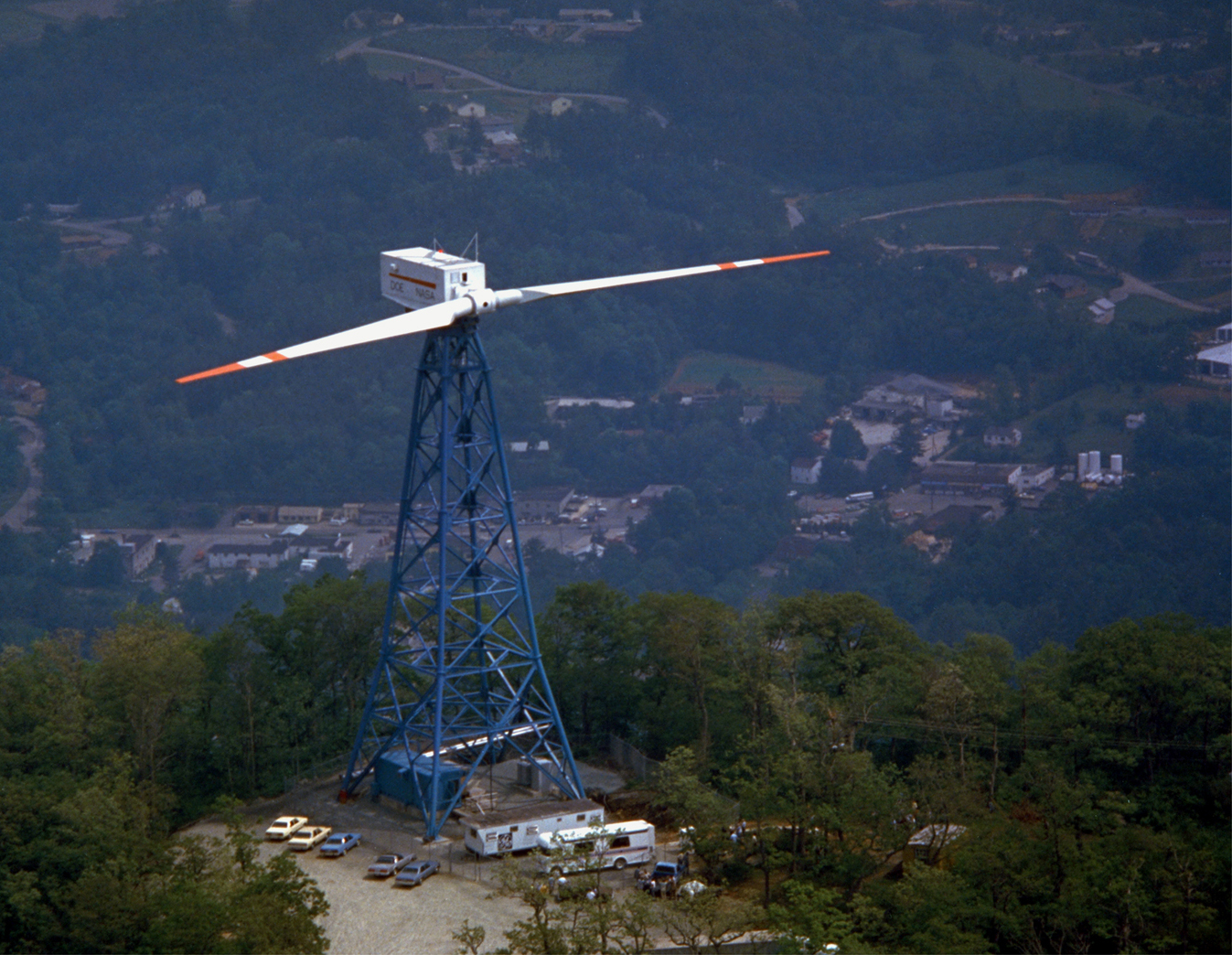Lloyd instances a report as an example of the threat wind turbines pose to the human race:
"A Proposed Metric for Assessing the Potential of Community Annoyance from Wind Turbine Low Frequency Noise Emissions"
"Our experience with the low-frequency noise emissions from a single, 2-MW MOD-I wind turbine demonstrated that, under the right circumstances, it was possible to cause annoyance within homes in the surrounding community with relatively low levels of LF-range acoustic noise."Sounds convincing, right? The MOD-I wind turbine was a downwind NASA prototype, built in 1978, and removed in 1981. The paper itself was published in 1987. This is 26 years ago (before the internet was commercially available, and around the time Microsoft Windows was released). From the Wiki page:
"Low-frequency noise from the heavy truss tower blocking the wind to the downwind rotor caused problems to residences located close by"
 |
| The wind hits the tower first, and then the blades. This is an old wind turbine. This is not the same as a newer wind turbine. |
There are no downwind wind turbines in Australia.
The South Australian EPA recently released a comparative report on low-frequency noise emissions from modern, upwind turbines, unmentioned by Lloyd in his article:
"Overall, this study demonstrates that low frequency noise levels near wind farms are no greater than levels in urban areas or at comparable rural residences away from wind farms. Organised shutdowns of the wind farms also found that the contribution of the Bluff Wind Farm to low frequency noise levels at Location 8 was negligible, while there may have been a relatively small contribution of low frequency noise levels from the Clements Gap Wind Farm at frequencies of 100Hz and above"Lloyd does elaborate that instancing a 26 year old report referring to a prototype, nonexistent wind turbine that was never installed in Australia isn't quite right:
'Clean Energy Council policy director Russell Marsh said the study was not relevant to modern turbines. "This is the equivalent of taking a study about Ataris and applying it to the latest iPads," Mr Marsh said.'So why report a decades-old piece of research on a prototype wind turbine like it's breaking news? It's a technique Lloyd has used before. Have a look at these sentences from an article published in April 2012:
"Village resident Neil Daws is concerned his chickens have been laying eggs with no yolks. Ironically called wind eggs, the yolkless eggs can be explained without wind turbines.By simply presenting two completely irrelevant facts in close proximity, Lloyd lets the reader assume the two are linked. You can literally do this with anything you want. You're limited only by your imagination:
But together with a spike in sheep deformities, also not necessarily connected to wind, reports of erratic behaviour by farm dogs and an exodus of residents complaining of ill health, Waterloo is a case study of the emotional conflict being wrought by the rollout of industrial wind power."
"Physicians found in 1702 that drilling a hole into someone's skull to remove evil spirits was largely unsuccessful. This revelation shows that modern neurosurgery is extremely dangerous"So where did Lloyd get this 26-year-old scoop?
"Yeah, the government and industry knew all about this shit in the 1980s. It’s now 2013, and the government and industry are still pretending they don’t know about this shit. Are you angry, yet?"Oh yes, it's our old, profane, hyperbolic friends, windturbinesyndrome.com, attempting to stimulate rage by distributing outdated research on prototype machines. Lloyd claims:
"The research was sent by an American acoustics expert to Australian wind health campaigners and has now been published internationally."Well, no, it was already published internationally. See here, here, here, here, here, here, here, here, here....you get the idea. It's an old piece of research, that's been mindlessly re-hashed by anti-wind groups and picked up by Lloyd with motivated glee.
In the absence of evidence of any harm from wind turbines, awkwardly and unashamadely shoe-horning irrelevant, outdated research into contemporary media is, presumably, the last resort for both bile-flecked clipart-ridden blogs like WTS.com and one of Australia's biggest news outlets.

This study is but one of a great many from the 1980s regarding wind turbine noise and particularly low-frequency noise. See the 29-page 1988 bibliography at https://www.wind-watch.org/documents/wind-turbine-acoustics-research-bibliography-with-selected-annotation/
ReplyDeleteThe news would seem to be that the industry has pretended this research never existed.
Is The Australian desperate for a diversion from petroleum-fueled death and destruction in Quebec?
ReplyDeleteWhat is also interesting about this early study is that it was in response to annoyance complaints from about a dozen families out of more than 1000 living within 3 km from the turbine, which is in concordance with current reports reflecting that only a fraction of people are sensitive to such noise and live in structures that aggravate it.
ReplyDeleteKetan, you are just another zombie academic like Simon Chapman who doesn't recognise their own internalised biases. You haven't demolished the case at all. Same symptoms today, just a different mechanism now.
ReplyDeleteHi anonymous,
DeleteI'm not an academic, but thanks for playing!
Hugs,
Ketan
Generating energy by means of renewable resources is a perfect and environment friendly idea.You really described well for wind turbines. Keep writing.
ReplyDeleteThe results of the survey seem dated. Wind turbines are hugely popular among modern homeowners as a medium to reduce monthly energy bills. Also, one has several options to generate wind energy without generating noise, and causing damage to the ecology.
ReplyDelete